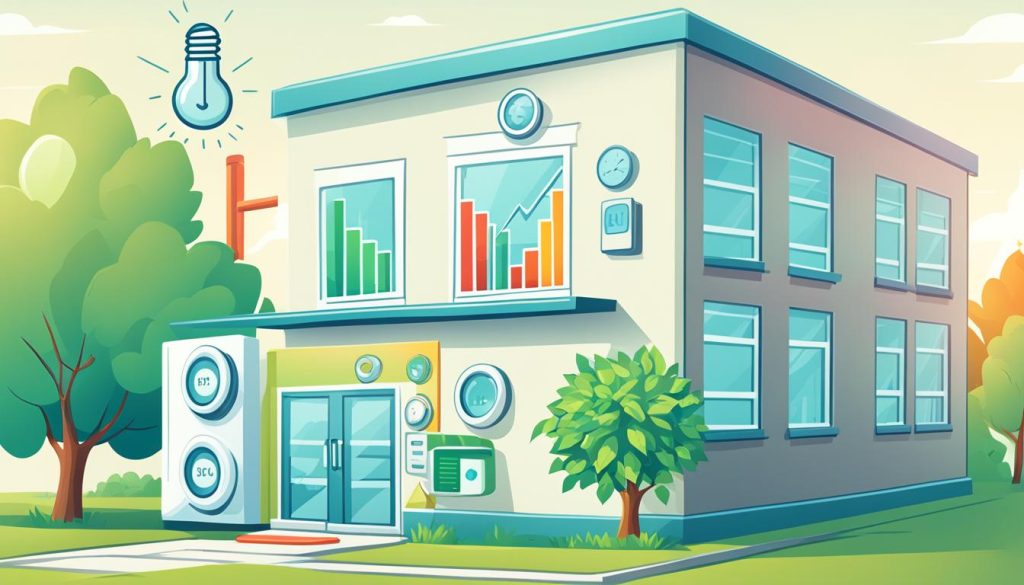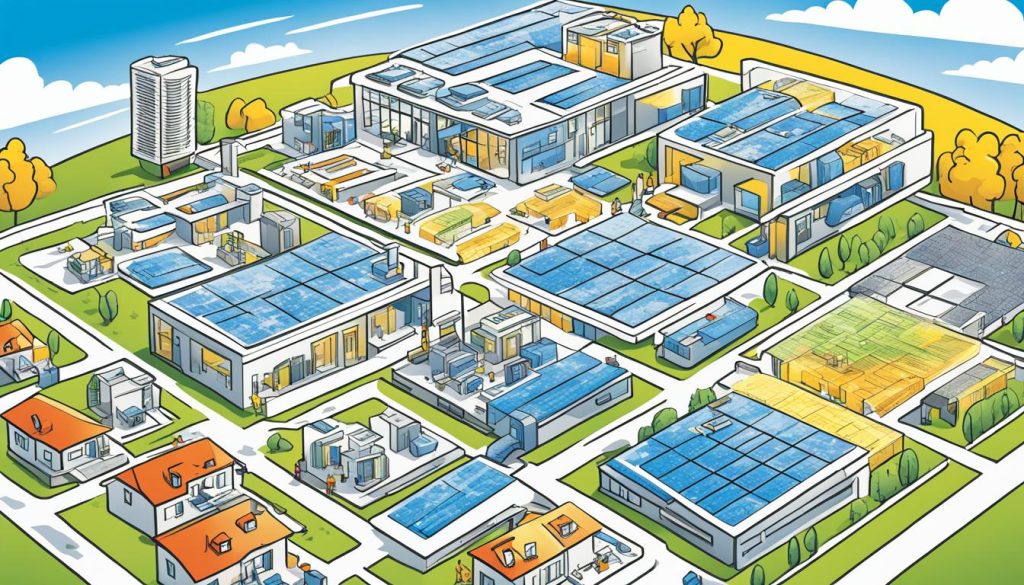You can find ways to cut down on your HVAC system’s load by doing free calculations. These calculations help figure out the best size and efficiency for your HVAC system. This leads to better energy use and lower costs.
Calculating your HVAC load is key to making your heating and cooling systems work better. With free HVAC software, you can analyze your building’s cooling and heating needs. This helps you understand what your building really needs.
The Manual J Load Calculation is the top method for homes, made by the Air Conditioning Contractors of America (ACCA). It requires detailed info about your building, figuring out heat loss and gain, and picking the right HVAC size.
Free HVAC calculations can show you how to reduce your load. You might need to improve insulation, change windows, or manage internal heat better. Making these changes can save a lot of energy and make your space more comfortable.
Understanding HVAC Load Calculations
HVAC load calculations are key to designing efficient heating and cooling systems for buildings. They help figure out the right size of HVAC equipment needed. This ensures indoor temperatures stay comfortable.
What are HVAC load calculations?
HVAC load calculations estimate how much heating or cooling a building needs. They look at building size, insulation, window types, and local climate. The aim is to get an accurate measure of heat gain and loss.
Importance of accurate load calculations
Getting the HVAC system size right is crucial for best performance and energy use. Systems that are too big waste energy and cycle on and off too much. Ones that are too small can’t keep the space comfortable. Accurate calculations mean your HVAC works well all year.
Manual J Load Calculation overview
The Manual J Load Calculation is the top method for figuring out HVAC needs in homes. It’s a detailed way to look at building data and find out what heating and cooling is required. It looks at many factors that affect how heat moves in a home.
| Factor | Impact on Load Calculation |
|---|---|
| Building size | Larger spaces need more heating/cooling |
| Insulation quality | Better insulation cuts down on heat transfer |
| Window types | Windows that save energy reduce heat gain/loss |
| Local climate | Hotter or colder places mean more HVAC load |
Using Manual J Load Calculation, HVAC experts can size systems just right. This ensures your home is comfortable and uses energy wisely.
Benefits of Free HVAC Calculation Tools
Free HVAC software has big perks for contractors and homeowners. It makes figuring out heating and cooling loads easier. This leads to better energy use and lower costs. These tools use smart algorithms for precise results, helping with HVAC optimization.
These tools are easy to use, even if you’re not a tech expert. You can put in your data and get important info easily. This lets you make smart choices about your HVAC system without always needing experts.
Using free HVAC software saves a lot of time. What used to take hours now takes just minutes. This means you can try out different options fast. It helps with planning and designing your HVAC system better.
| Benefit | Impact |
|---|---|
| Improved Accuracy | Reduced risk of over or undersizing HVAC systems |
| User-Friendly Interface | Easier access to professional-grade calculations |
| Time Savings | Faster decision-making and project planning |
| Customization Options | Tailored results for unique building characteristics |
With these free tools, you can get your HVAC system running at its best. You’ll use less energy and pay less on bills. You can also customize the calculations for your building’s specific needs. This makes your HVAC system work better for you, keeping you comfortable and efficient.
Key Factors Influencing HVAC Loads
Understanding what affects HVAC loads is key to making your building more energy efficient. These factors are crucial in figuring out how much heating and cooling your space needs.
Building Size and Layout
The size and design of your building affect its heating and cooling needs. Bigger buildings need more energy to stay comfortable. Also, open floor plans might need special HVAC setups compared to rooms divided by walls.
Insulation and Construction Materials
The insulation quality and building materials used impact how well heat moves around. Good insulation keeps temperatures steady inside and cuts down on HVAC work.
Windows and Doors
Windows and doors can let in a lot of heat or cold. Their size, type, and position change how much solar heat gets in and how much air leaks out.
Occupancy and Internal Heat Sources
People, appliances, and gadgets in your space add extra heat. This heat affects how much cooling your HVAC system needs.
Local Climate Considerations
Your local climate is key in figuring out heating and cooling needs. Things like outdoor temperature, humidity, and the seasons change how your HVAC works.
| Factor | Impact on HVAC Load |
|---|---|
| Building Size | Larger spaces require more energy |
| Insulation Quality | Better insulation reduces heat transfer |
| Window Type | Affects solar heat gain and air leakage |
| Occupancy | More people increase internal heat load |
| Climate Zone | Determines overall heating/cooling needs |
How to Use Free HVAC Calculations to Identify Load Reduction Opportunities
Free HVAC calculations are great for finding ways to cut down on energy use in your building. By looking at your building’s details and how much energy it uses, you can find spots to get better. This helps you make plans to use less energy.
First, collect important info like how big your building is, its insulation quality, how much sun it gets, what kind of windows it has, and how many people use it. Then, use free HVAC tools to figure out the best size for your equipment and how much cooling you need.

After that, compare what the calculations say with how much energy you’re using now. This shows you where you can make changes to use less energy. Making these changes can really help cut down on energy use and costs.
Key Benefits of Free HVAC Calculations
- Accurate sizing of HVAC equipment
- Identification of energy-wasting areas
- Development of targeted load reduction strategies
- Optimization of HVAC system performance
Using these free tools helps you make smart choices about upgrading to use less energy. This leads to a more comfortable building, lower energy bills, and a greener operation.
| Building Feature | Load Reduction Strategy | Potential Impact |
|---|---|---|
| Insulation | Upgrade to higher R-value materials | 10-20% energy savings |
| Windows | Install low-E, double-pane windows | 15-30% reduction in heat gain/loss |
| Lighting | Switch to LED fixtures | 30-50% decrease in lighting energy use |
| HVAC Controls | Implement smart thermostats | 10-15% reduction in HVAC energy consumption |
Step-by-Step Guide to Performing Free HVAC Calculations
Free HVAC calculations are key for getting your system right. They help with load analysis and sizing. This guide will show you how to get started, from collecting data to understanding the results.
Gathering Building Data
Begin by collecting important building details. Measure the size of each room and note the insulation types. Also, count the number of windows and doors. Remember to include the building’s direction and the local climate.
Inputting Information into Calculation Tools
After collecting data, use calculation tools. Enter details like room sizes, insulation R-values, window information, and how many people will use the space. Many free tools make this easy with simple interfaces.
| Building Feature | Data to Input |
|---|---|
| Room Dimensions | Length, width, height |
| Insulation | R-value, thickness |
| Windows | Size, type, orientation |
| Occupancy | Number of people, usage patterns |
Interpreting Results
Once you’ve entered your data, the tool will show you results. These include how much heat your building gains or loses, and what HVAC system size is best. Use this info to see where you can improve and make smart choices for your HVAC.
By using this guide, you’ll understand your building’s HVAC needs better. This helps with more efficient and cost-saving system designs.
Identifying Load Reduction Opportunities
After doing HVAC calculations, you can find spots for energy-efficient upgrades. By looking at the results, you’ll see ways to use less energy and feel more comfortable. Let’s see how to find and use these chances for cost-effective improvements.

Begin by comparing your calculated loads with your current energy use. This shows where your system might be overworking. Look for these main areas:
- Insulation gaps
- Inefficient windows and doors
- Excessive internal heat sources
- Poor air sealing
Focus on upgrades that give you the most value. Sealing air leaks is often cheap but highly effective. Upgrading insulation can greatly cut heating and cooling loads.
Think about these strategies for reducing load:
| Strategy | Potential Impact | Typical Cost |
|---|---|---|
| Air sealing | 10-20% energy savings | Low |
| Insulation upgrade | 15-30% energy savings | Medium |
| Window replacement | 10-25% energy savings | High |
| HVAC optimization | 5-15% energy savings | Low to Medium |
By focusing on these areas, you can make big improvements in HVAC efficiency. Remember, small changes can add up to big savings over time. Start with the most impactful and cost-effective improvements for the best results in reducing your load.
Common HVAC Load Calculation Mistakes to Avoid
Getting HVAC load calculations right is key to efficient heating and cooling. Yet, many pros make mistakes that can cause poor climate control and higher energy bills. Let’s look at common errors and how to dodge them for better load assessments.
Neglecting Insulation Quality
Many overlook the role of insulation quality in HVAC calculations. Bad insulation can change heating and cooling needs a lot. When checking the building, make sure to look at the R-value of insulation in walls, ceilings, and floors. Remember, not all insulation is the same – its quality can change your HVAC load calculations a lot.
Overlooking Window Characteristics
Windows are key in how much heat a building loses or gains. Many pros don’t think about window size, type, and direction when figuring out loads. Single-pane windows let more heat pass through than double-pane or low-E glass. And south-facing windows can add to summer heat gain. Make sure to include these details in your calculations for a better load assessment.
Ignoring Internal Heat Sources
Another big mistake is not considering internal heat sources. People, lights, appliances, and gadgets all add heat. Not thinking about these can lead to cooling systems that are too small or heating units that are too big. When doing HVAC load calculations, think about how many people will be there and the heat from regular equipment.
Avoiding these common mistakes means getting a more accurate load assessment. This leads to systems that are just the right size, better energy use, and more comfort for people living or working there.
Implementing Load Reduction Strategies
Now that we’ve found ways to reduce load, it’s time to act. Making your HVAC system more efficient can lower your energy bills and make your space more comfortable. Let’s look at the best ways to improve.
Improving Insulation
Boosting your building’s insulation is key to reducing HVAC load. Focus on walls, attics, and floors to stop heat from escaping. Here are some suggestions:
- Spray foam insulation for hard-to-reach areas
- Fiberglass batts for walls and attics
- Rigid foam boards for basement walls
Upgrading Windows and Doors
Old windows and doors can waste a lot of energy. Switching to energy-efficient ones can make a big difference:
- Double or triple-pane windows with low-E coatings
- Energy Star certified doors with proper weatherstripping
- Storm windows and doors for extra insulation
Optimizing Internal Heat Sources
Controlling internal heat is important for reducing HVAC load. Here’s how to make your space more efficient:
- Switch to LED lighting to reduce heat output
- Use Energy Star appliances to minimize excess heat
- Implement smart controls to manage electronics usage
By using these strategies, you’ll make your building more energy-efficient. This not only lowers HVAC costs but also improves comfort and sustainability.
Case Studies: Successful Load Reduction Projects
Discover real-world HVAC optimization examples that show big energy savings. These stories prove how smart calculations and targeted improvements work well.
A mid-size office in Chicago cut its energy bills by 30% with new HVAC advice. The manager used online tools to find where their system was losing energy. They improved insulation and changed old windows, which greatly lowered heating and cooling needs.
In Phoenix, a retail store chain made big changes across many stores. They used free software to find where they could save energy. By getting better roofing and smart thermostats, they cut energy use by 25%.
| Project | Location | Energy Savings | Key Improvements |
|---|---|---|---|
| Office Building | Chicago | 30% | Insulation, Windows |
| Retail Chain | Phoenix | 25% | Roofing, Smart Thermostats |
A school district in Minnesota worked on a big HVAC project. They looked at load calculations for each building to see where to spend money first. They put in energy-recovery ventilators and fixed air leaks, cutting heating costs by 40% in the cold months.
These stories show how free HVAC calculations help save energy and money. By finding where to cut energy use, places can save a lot and make people more comfortable.
Advanced Techniques for HVAC Optimization
Building managers can boost HVAC efficiency with the latest optimization methods. Energy modeling software helps predict how buildings will perform under different conditions. This lets you find ways to cut down on energy use.
Building automation systems link HVAC controls with other building systems for better energy management. They let you control and monitor everything from one place. This makes it easier to spot and fix energy-wasting areas in your building.
Smart HVAC controls use sensors and smart algorithms to make your system work better. They adjust settings based on how many people are there and the weather. This way, you stay comfortable without wasting energy.
Predictive maintenance is a key tool for keeping your HVAC system running smoothly. It looks at your system’s data to predict problems before they happen. This means less downtime and longer equipment life.
| Optimization Technique | Benefits | Implementation Challenges |
|---|---|---|
| Energy Modeling | Identifies potential savings, simulates various scenarios | Requires accurate input data, expertise to interpret results |
| Building Automation Systems | Centralizes control, improves overall efficiency | Initial cost, integration with existing systems |
| Smart HVAC Controls | Adapts to real-time conditions, reduces energy waste | Sensor placement, algorithm fine-tuning |
| Predictive Maintenance | Reduces downtime, extends equipment life | Data collection infrastructure, analysis expertise |
Using these advanced techniques can greatly improve your HVAC system’s performance and efficiency. The trick is to pick the right mix of strategies for your building’s specific needs.
Conclusion
Free HVAC calculations are great for making your HVAC system more efficient and saving energy. They help you find ways to use less energy and make your building work better. By understanding what affects your HVAC loads, you can make smart changes to save money and make your space more comfortable.
Reducing your HVAC load does more than just save energy. It also makes your equipment last longer and helps with green building practices. As technology gets better, you’ll have more ways to make your building use energy wisely.
Using free HVAC calculations and strategies means you’re saving money and helping the planet. These tools help you make smart choices about how your building uses energy. By keeping your HVAC systems in top shape, you’re helping create spaces that are efficient, cozy, and good for the earth.





0 Comments